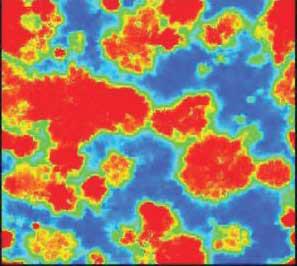
A false-color, simulated snapshot of doubly ionized helium in the universe when it was only about 2.5 billion years old; the frame has a dimension of about 1.4 billion light-years.
In its earliest years, the universe was so hot that electrons and protons could not stay together to form neutral atoms; matter was said to be in ionized form. But after 380,000 years, when the universe had cooled enough, electrons did combine with protons to make neutral atoms, mostly hydrogen (about 75%) and helium (about 25%). Much later in cosmic history -- the precise dating is a very active area of current research but perhaps after a few hundred million years -- the first generation of stars emerged from the vast expanses of atomic gas, and these stars emitted enough strong ultraviolet light to re-ionize the hydrogen in their vicinity. As the universe continued to expand and evolve, newer generations of stars continued to re-ionize the neutral hydrogen in their vicinities. Re-ionization is an important effect because it signals where stars are being made, and when it is observed at cosmic distances it provides important details about the creation and early evolution of the universe.
Searching for signs of ionized hydrogen from tens of billions years ago is not a simple task. One way in which cosmic reionization studies do it is by taking advantage of the stupendous luminosities of distant quasars. Quasars are galaxies with massive black holes around which vast amounts of energy are being radiated; indeed, quasars are among the most powerful energy sources known. Although they are comparatively rare, quasars are so bright they can be seen even when they are very far away: at cosmological distances, and thus at early epochs of the universe when galaxies were adolescent. If any clouds of ionized hydrogen happen to lie between us and a quasar, astronomers can detect them because they absorb the quasar's light at characteristic optical wavelengths. Indeed, the first detection of these clouds was made in the 1960's, although from quasars that are among the ones closer to us.
Hydrogen is not the only element that can be re-ionized -- helium can as well. Helium, however, is much harder to re-ionize. Ultraviolet photons need about four times the energy to re-ionize helium into its highest state than to re-ionize hydrogen. This means only the most powerful sources can generate enough ultraviolet, and that means the conditions in the vicinity must be quite extreme. Helium re-ionization has also been detected in absorption to some quasars. Understanding the implications of this helium re-ionization has, however, so far been a difficult challenge.
Harvard graduate student Matthew McQuinn led a team of six other CfA scientists, Adam Lidz, Matias Zaldarriaga, Lars Hernquist, Philip Hopkins, Suvendra Dutta, and Claude-Andre Faucher-Giguere, in a study of the re-ionization of helium atoms in the young cosmos. McQuinn, who has just received his Ph.D. degree, did the research as part of his thesis. The team's theoretical models and simulations find overall consistency with observation, and conclude that intense quasars can re-ionize helium. The results also signal that temperatures in those regions can be 15,000 kelvin higher than otherwise expected, in agreement with other temperature measurements of the intergalactic gas.
The astronomers report that the powerful ultraviolet light responsible for helium re-ionization can traverse distances of many tens of millions of light-years, and can generate helium "bubbles" whose edges may be quite distant from the quasars themselves. The paper marks a significant advance in our ability to understand the conditions in gas clouds at cosmic distances, and the conditions in the early universe.